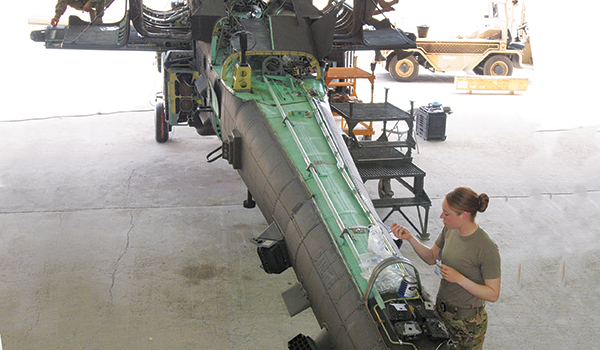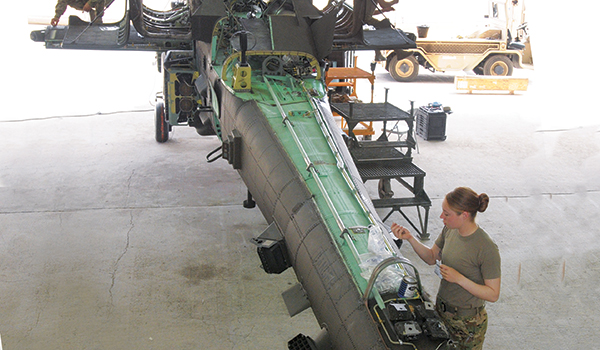
Branch Command Sergeant Major / By CSM Gregory M. Chambers and LTC Thomas W. Bamford: In response to the Holistic Aviation Assessment Task Force findings and recommendations, U.S. Army Training and Doctrine Command (TRADOC) led the Army’s effort to implement an aviation maintenance training program in order to build aviation maintenance proficiency back into the Branch.

Soldiers of D Troop, 4th Reconnaissance Squadron, 6th Calvary Regiment work on their individual sections of the AH-64E during the 500-hour phase maintenance on April 29 at Camp Taji, Iraq. / U.S. ARMY PHOTO BY SSG ISOLDA REYES, 29TH COMBAT AVIATION BRIGADE

Program Overview
The program creates gates and training folders akin to the Aviator Readiness Level (RL) program which develops skills based on repeated training and iterations of tasks, and ties Aviation Badges to successful completion of the annual task lists and online Blackboard skill level tests. Here is a macro look at the program.
The program will include approximately 18,500 Soldiers in the ranks of private to sergeant preparing for the Advanced Leaders Course (ALC), and approximately 22,700 personnel when we add staff sergeants across all components – Active, Reserve, and National Guard. Military Occupational Specialties within the program are: 15B, 15D, 15E, 15F, 15G, 15H, 15N, 15R, 15T, 15U, and 15Y.
- Adds a comprehensive End of Course test (written and hands-on) to the end of Advanced Individual Training (AIT) demonstrating MOS proficiency prior to graduation. 2nd Bn., 210th Avn. is already doing this now at Joint Base Langley-Eustis (JBLE) for all its AIT students. n On arrival to the first unit of assignment the Soldier is integrated into and must progress though the program.
- Continues with annual iterations to include online Blackboard skill level testing (maintained by USAACE).
- Prerequisite for starting ALC is success in program which includes passing the annual Skill Level 20 hands-on and written test.
- Upon successful completion of ALC and one year in program post ALC graduation, SM is awarded Senior Wings.
- Program continues through Senior Leaders Course (SLC) and award of Master Wings.
- What this does for the Soldier and the unit leaders: standardizes maintenance training, provides predictability to the maintainer and the gaining units, provides command teams reasonable assurance of the level of training of maintainers, and provides a regulatory basis for guarding maintenance training time.
- What this does NOT do for unit leaders is add a requirement; AR 750-1 has required a maintainer program for at least 10 years and it cannot reduce readiness. Tasks must be trained without taking an aircraft down; training can be conducted in a classroom or through simulation.
Testing
Testing will be critical to the program as it will drive what is studied. Annual exams will be the key to the program as these will drive where a Soldier/NCO puts his or her efforts in studying. An annual skill level test will be required regardless of assignment. This will keep maintainers focused on maintenance even while serving as a Recruiter, APMS, Drill Sergeant or any other duty. These tests will be loaded on Blackboard and accessible from any CAC-enabled computer. The individual will only need a local proctor to administer the test. Content of the Skill Level 10 test will be created at the appropriate AIT battalion. 20 and 30 Level tests will be built and maintained by the Non-commissioned Officer Academy at JBLE.
Much like the Non-Rated Crew Member RL progression program, the AMTP will have Army level mandated critical tasks and local commander tasks. The Army level tasks are selected by a Critical Task Site Selection Board every 36 months and the board determines the tasks to be trained at resident courses, such as AIT and ALC, and unit trained tasks.
How We Train
As with any program, much will depend on the how we train these tasks. Critical to this training is explaining the “why”—why we are doing what we do, not just the how. In order to train a task to standard, the trainer must explain everything that leads up to the task, everything that follows, why each of these actions are needed, and how they tie into a larger system. Maintainers need to train and demonstrate an understanding of how to manage available resources to complete the assigned task successfully. This includes describing how the elements of individual tasks work within the larger context of the respective system. They must be able to explain the basics of any system, showing an understanding of each part and how it functions. Knowing how the components operate will also help build a better Soldier who can troubleshoot any aircraft issues.
This program is intended as part of an overall approach to make the Aviation Enterprise and its Soldiers ready for an uncertain future combat environment. It should regain maintenance excellence and skills through a progressive, cumulative, regulatory training path which professionally develops our maintainers’ skills and understanding of their craft.
Above the Best!
CSM Chambers
This email address is being protected from spambots. You need JavaScript enabled to view it.
CSM Gregory M. Chambers is the command sergeant major of the Aviation Branch and the U.S. Army Aviation Center of Excellence, Fort Rucker, AL; LTC Thomas W. Bamford is the commander of 2nd Bn., 210th Avn. Regt., 128th Avn. Bde. at Joint Base Langley-Eustis, VA.





















